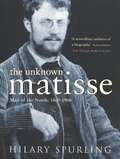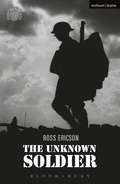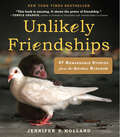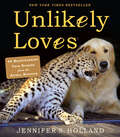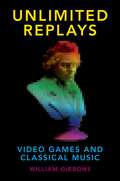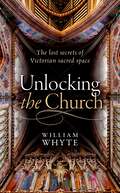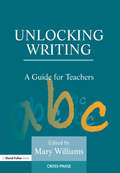- Table View
- List View
University Spatial Development and Urban Transformation in China
by Cui LiuThe past few decades have seen universities take on a leading role in urban development, actively providing public services beyond teaching and research. The relationship between the university and the city has great influence on the space of university, which is vividly reflected in the process of university spatial development. This process has been particularly evident in China as Chinese universities and cities have been undergoing dramatic transformations since reform in the late 1970s. University Spatial Development and Urban Transformation in China explores the changing relationship between the university and the city from a spatial perspective. Based on theories and discourses on the production of space, the book analyzes case studies in university spatial development in China at three scales – global, national and local – covering social and urban contexts, the urban transformation, interactions in the development process and the changing dynamic between university and city to propose mutually beneficial planning strategies. This book is a valuable resource for academics, researchers and urban planners in identifying the key factors and relationships in university spatial development using theoretical and empirical data to guide future urban planning.
University Spatial Development and Urban Transformation in China
by Cui LiuThe past few decades have seen universities take on a leading role in urban development, actively providing public services beyond teaching and research. The relationship between the university and the city has great influence on the space of university, which is vividly reflected in the process of university spatial development. This process has been particularly evident in China as Chinese universities and cities have been undergoing dramatic transformations since reform in the late 1970s. University Spatial Development and Urban Transformation in China explores the changing relationship between the university and the city from a spatial perspective. Based on theories and discourses on the production of space, the book analyzes case studies in university spatial development in China at three scales – global, national and local – covering social and urban contexts, the urban transformation, interactions in the development process and the changing dynamic between university and city to propose mutually beneficial planning strategies. This book is a valuable resource for academics, researchers and urban planners in identifying the key factors and relationships in university spatial development using theoretical and empirical data to guide future urban planning.
University Trends: Contemporary Campus Design
by Jonathan Coulson Paul Roberts Isabelle TaylorThe campus has a deep-rooted prestige as a place of teaching, learning and nurturing. Conjuring images of cloistered quadrangles, of sunny lawns, of wood-panelled libraries, it is a word viscerally charged with centuries of scholarly tradition. And yet it is also a place of cutting-edge science, vibrancy and energy. It is this dual nature, this concurrent adherence to tradition and innovation, which renders the physical environment of the university such a redolent, enduring and dynamic realm. However, it also means that the twenty-first-century campus is a highly challenging and exacting landscape to design and manage successfully. Today, the scale of the pressures and the rate of change facing higher education institutions are greater than ever. Squeezed public spending, growing societal expectations and the broadening education ambitions of developing nations are set against a backdrop of rapid technological progress and changing pedagogies. What are the repercussions for the physical realities of university planning and architecture? And how are university campuses adapting to contend with these pressures? University Trends: Contemporary Campus Design introduces the most significant, widespread and thought-provoking trends that are currently shaping the planning and architecture of higher education institutions across the world. Within this completely revised second edition, Part One identifies current patterns such as hub buildings, large-scale expansions, adaptive reuse and innovation buildings. Part Two profiles these through recent, well-illustrated, global case studies. The essential guide to current and future trends in campus design.
University Trends: Contemporary Campus Design
by Jonathan Coulson Paul Roberts Isabelle TaylorThe campus has a deep-rooted prestige as a place of teaching, learning and nurturing. Conjuring images of cloistered quadrangles, of sunny lawns, of wood-panelled libraries, it is a word viscerally charged with centuries of scholarly tradition. And yet it is also a place of cutting-edge science, vibrancy and energy. It is this dual nature, this concurrent adherence to tradition and innovation, which renders the physical environment of the university such a redolent, enduring and dynamic realm. However, it also means that the twenty-first-century campus is a highly challenging and exacting landscape to design and manage successfully. Today, the scale of the pressures and the rate of change facing higher education institutions are greater than ever. Squeezed public spending, growing societal expectations and the broadening education ambitions of developing nations are set against a backdrop of rapid technological progress and changing pedagogies. What are the repercussions for the physical realities of university planning and architecture? And how are university campuses adapting to contend with these pressures? University Trends: Contemporary Campus Design introduces the most significant, widespread and thought-provoking trends that are currently shaping the planning and architecture of higher education institutions across the world. Within this completely revised second edition, Part One identifies current patterns such as hub buildings, large-scale expansions, adaptive reuse and innovation buildings. Part Two profiles these through recent, well-illustrated, global case studies. The essential guide to current and future trends in campus design.
University Trends: Contemporary Campus Design
by Jonathan Coulson Paul Roberts Isabelle TaylorThe campus has a deep-rooted prestige as a place of teaching, learning and nurturing. Conjuring images of cloistered quadrangles, of sunny lawns, of wood-panelled libraries, it is a word viscerally charged with centuries of scholarly tradition. And yet it is also a place of cutting-edge science, vibrancy and energy. It is this dual nature, this concurrent adherence to tradition and innovation, which renders the physical environment of the university such a redolent, enduring and dynamic realm. However, it also means that the twenty-first-century campus is a highly challenging and exacting landscape to design and manage successfully. Today, the scale of the pressures and the rate of change facing higher education institutions are greater than ever. Squeezed public spending, growing societal expectations and the broadening education ambitions of developing nations are set against a backdrop of rapid technological progress and changing pedagogies. What are the repercussions for the physical realities of university planning and architecture? And how are university campuses adapting to contend with these pressures? University Trends: Contemporary Campus Design introduces the most significant, widespread, and thought-provoking trends that are currently shaping the planning and architecture of higher education institutions across the world. Within this completely revised third edition, Part One identifies current patterns such as student hubs, large-scale expansions and buildings for innovation and interdisciplinary research. Part Two profiles these through recent, well-illustrated, global case studies. This is the essential guide to current and future trends in campus design.
University Trends: Contemporary Campus Design
by Jonathan Coulson Paul Roberts Isabelle TaylorThe campus has a deep-rooted prestige as a place of teaching, learning and nurturing. Conjuring images of cloistered quadrangles, of sunny lawns, of wood-panelled libraries, it is a word viscerally charged with centuries of scholarly tradition. And yet it is also a place of cutting-edge science, vibrancy and energy. It is this dual nature, this concurrent adherence to tradition and innovation, which renders the physical environment of the university such a redolent, enduring and dynamic realm. However, it also means that the twenty-first-century campus is a highly challenging and exacting landscape to design and manage successfully. Today, the scale of the pressures and the rate of change facing higher education institutions are greater than ever. Squeezed public spending, growing societal expectations and the broadening education ambitions of developing nations are set against a backdrop of rapid technological progress and changing pedagogies. What are the repercussions for the physical realities of university planning and architecture? And how are university campuses adapting to contend with these pressures? University Trends: Contemporary Campus Design introduces the most significant, widespread, and thought-provoking trends that are currently shaping the planning and architecture of higher education institutions across the world. Within this completely revised third edition, Part One identifies current patterns such as student hubs, large-scale expansions and buildings for innovation and interdisciplinary research. Part Two profiles these through recent, well-illustrated, global case studies. This is the essential guide to current and future trends in campus design.
The Unknown Matisse: Man of the North: 1869-1908
by Hilary SpurlingAstonishing and essential, the biography that reclaimed Henri Matisse from history's slanders and restored his place in the canon of the 20th century's greatest artistsBefore acclaimed biographer Hilary Spurling turned her attention to Henri Mattise, precious few facts were known about his life - and those few were distorted by inaccuracy, misunderstanding and glaring gaps. The Unknown Matisse investigates the secret life of The Wild Beast (as he was known), whose early paintings shocked and enraged his contemporaries. It tells the story of an innovative genius, born in war-torn, poverty-stricken Flanders who finally overcame hardship and disaster to fulfil Van Gogh's prophecy: 'The painter of the future will be such a colourist as has never yet been.'
Unknown New York: An Artist Uncovers the City's Hidden Treasures
by Jesse RichardsAn intrepid and gifted artist uncovers and illustrates more than 100 surprising, enchanting, and sometimes downright bizarre nooks and crannies that make New York such a compelling city. It&’s no surprise that New York City is the most visited destination in the U.S., and has proved itself to be an endlessly fascinating exploration ground to visitors and natives alike. Unknown New York walks readers through the vibrant, hidden, and forgotten worlds churning beneath the surface of the city. From the oldest bridge -- a footbridge described as a &“red sidewalk through the sky&” -- to a quirky and little-known Superhero Supply Store in Brooklyn to the original and abandoned Hall of Fame in the Bronx, the author takes us on a magical mystery tour through the city many people think they know. Each entry presents a brief and compelling description of a hidden park, historical site, niche shop, etc and is accompanied by a charming four-color illustration by the author. Divided into chapters titled Hidden History, Humble Parks, On the Street, Shopping Spree, Quiet Realms, Central Park, and Excusions, Jesse Richards reveals to us such extraordinary sites as the first Hall of Fame, a church where an attempted assassination took place in the 1800&’s, a part of the Bronx that resembles Capri, the many pocket parks hidden in plain sight, the less frequented corners of Central Park, unusual shops conveying surprising items for all ages, a waterfall tunnel in midtown, and so much more. Also included are curated walks to lead you to several sites in an afternoon. There&’s a Downtown River Walk, Neighborhood Parks Walk, Midtown Book-Lover&’s Walk, and a Hidden Central Park Walk.
The Unknown Soldier (Modern Plays)
by Ross EricsonDon't, for God's sake, come back alive 'cause we don't want to see your ugly stumps and your ugly scars. We don't want to hear your midnight screams and tales of hell. We all got along nicely without you, thank you very much, and now you're back you remind us things we'd much rather forget. More convenient, ain't it? To have a dead hero. A dead hero don't have complaints. A dead hero don't even have a voice.Jack stayed on when the guns fells silent, to search the battlefields for the boys that could not go home - for the dead and the missing, for both enemy and friend. And amongst the rusty wire and unexploded bombs, Jack is looking for something - looking for someone. He has a promise to keep and debt to repay, and now there is this strange request from the generals.A story of comradeship, betrayal and of promises both broken and kept following the carnage of World War One from the acclaimed writer of Casualties, Ross Ericson. It received its world premiere at the Edinburgh Festival Fringe 2015 before embarking on a UK tour.
The Unknown Soldier (Modern Plays)
by Ross EricsonDon't, for God's sake, come back alive 'cause we don't want to see your ugly stumps and your ugly scars. We don't want to hear your midnight screams and tales of hell. We all got along nicely without you, thank you very much, and now you're back you remind us things we'd much rather forget. More convenient, ain't it? To have a dead hero. A dead hero don't have complaints. A dead hero don't even have a voice.Jack stayed on when the guns fells silent, to search the battlefields for the boys that could not go home - for the dead and the missing, for both enemy and friend. And amongst the rusty wire and unexploded bombs, Jack is looking for something - looking for someone. He has a promise to keep and debt to repay, and now there is this strange request from the generals.A story of comradeship, betrayal and of promises both broken and kept following the carnage of World War One from the acclaimed writer of Casualties, Ross Ericson. It received its world premiere at the Edinburgh Festival Fringe 2015 before embarking on a UK tour.
Unknown Universe: Discover hidden wonders from deep space unveiled by the James Webb Space Telescope
by null Tom Kerss Collins AstronomyA lens into the unexplored and unseen cosmos A beautiful book showcasing the most stunning images from the first years of the James Webb Space Telescope, the most powerful infrared space observatory, along with expert insights into their revelations. Discover how these awe-inspiring images enhance our understanding of the Cosmos, and what new mysteries they unlock for astronomers. Learn more about humanity's mission to explore the far reaches of the Universe. Discover the history and background of the JWST, its technical design (size, optical system, heat shield and orbit), how the incredible observatory's instruments work, and why its striking images look the way they do. Tom Kerss provides accessible commentary, explaining the images in non-scientific terms whilst introducing the astronomical jargon used by the experts. He presents his own previously unpublished images, processed from real data, and presents both the answers and questions brought to light by the engine of wonder that is the James Webb Space Telescope.
The Unknown World of the Mobile Home (Creating the North American Landscape)
by John Fraser Hart Michelle J. Rhodes John T. MorganIn American popular imagination, the mobile home evokes images of cramped interiors, cheap materials, and occupants too poor or unsavory to live anywhere else. Since the 1940s and '50s, however, mobile home manufacturers have improved standards of construction and now present them as an affordable alternative to conventional site-built homes. Today one of every fourteen Americans lives in a mobile home. In The Unknown World of the Mobile Home authors John Fraser Hart, Michelle J. Rhodes, and John T. Morgan illuminate the history and culture of these often misunderstood domiciles. They describe early mobile homes, which were trailers designed to be pulled behind automobiles and which were more often than not poorly constructed and unequal to the needs of those who used them. During the 1970s, however, Congress enacted federal standards for the quality and safety of mobile homes, which led to innovation in design and the production of much more attractive and durable models. These models now comply with local building codes and many are designed to look like conventional houses. As a result, one out every five new single-family housing units purchased in the United States is a mobile home, sited everywhere from the conventional trailer park to custom-designed "estates" aimed at young couples and retirees. Despite all these changes in manufacture and design, even the most immobile mobile homes are still sold, financed, regulated, and taxed as vehicles.With a wealth of detail and illustrations, The Unknown World of the Mobile Home provides readers with an in-depth look into this variation on the American dream.
Unless the Threat of Death Is Behind Them: Hard-Boiled Fiction and Film Noir
by John T. IrwinEarly in the twentieth century a new character type emerged in the crime novels of American writers such as Dashiell Hammett and Raymond Chandler: the "hard-boiled" detective, most famously exemplified by Sam Spade in The Maltese Falcon. Unlike the analytical detectives of nineteenth-century fiction, such as Edgar Allan Poe’s Inspector Dupin, the new detectives encountered cases not as intricate logical puzzles but as stark challenges of manhood. In the stories of these characters and their criminal opposites, John T. Irwin explores the tension within ideas of American masculinity between subordination and independence and, for the man who becomes "his own boss," the conflict between professional codes and personal desires. He shows how, within different works of hard-boiled fiction, the professional either overcomes the personal or is overcome by it, ending in ruinous relationships or in solitary integrity, and how within the genre all notions of manly independence are ultimately revealed to be illusions subordinate to fate itself. Tracing the stylistic development of the genre, Irwin demonstrates the particular influence of the novel of manners, especially the writing of F. Scott Fitzgerald. He goes on to argue that, from the time of World War II, when hard-boiled fiction began to appear on the screen in film noir just as women entered the workforce in large numbers, many of its themes came to extend to female empowerment. Finally, he discusses how these themes persist in contemporary dramatic series on television, representing the conflicted lives of Americans into the twenty-first century.
Unlikely Friendships: 47 Remarkable Stories from the Animal Kingdom (Unlikely Friendships)
by Jennifer S. HollandThe most amazing friendships between species, collected from around the world, documented with full-color photographs, and narrated by New York Times bestselling author Jennifer Holland. The cat and the bird. The elephant and the sheep. The snake and the hamster. In all, 47 heartwarming and inspiring true tales of animal bonds.
Unlikely Loves: 43 Heartwarming True Stories from the Animal Kingdom (Unlikely Friendships)
by Jennifer S. HollandIn her inspiring New York Times bestseller Unlikely Friendships, Jennifer Holland introduced us to the heartwarming relationships that exist between animals of different species. Her stories struck a chord with thousands of readers, including Temple Grandin, who described the book as "amazing." Now Holland explores animal attachments that, in human terms, can only be called love. Packed with beautiful, breathtaking full-color photographs, Unlikely Loves is a celebration of love between species. Here are stories of parental love, like the Dalmatian who mothers a newborn lamb—a lamb that just happens to be white with black spots! Stories of playful love, including the fox and the hound who become inseparable. And stories of orphaned animals who have found family-like ties in unexpected combinations, like the elephant who&’s bonded with sea lions, goats, and other animals in her walks around the Oregon Zoo. Ms. Holland has interviewed scientists, zoologists, and animal caretakers from around the world, tracking down firsthand sources and eyewitnesses. The stories are written with journalistic integrity and detail—and always filled with the author&’s deep affection for her subjects.
Unlimited action: The performance of extremity in the 1970s (Theatre: Theory – Practice – Performance)
by Dominic JohnsonUnlimited action concerns the limits imposed upon art and life, and the means by which artists have exposed, refused, or otherwise reshaped the horizon of aesthetics and of the practice of art, by way of performance art. It examines the ‘performance of extremity’ as practices at the limits of the histories of performance and art, in performance art’s most fertile and prescient decade, the 1970s. Dominic Johnson recounts and analyses game-changing performance events by six artists: Kerry Trengove, Ulay, Genesis P-Orridge, Anne Bean, the Kipper Kids, and Stephen Cripps. Through close encounters with these six artists and their works, and a broader contextual milieu of artists and works, Johnson articulates a counter-history of actions in a new narrative of performance art in the 1970s, to rethink and rediscover the history of contemporary art and performance.
Unlimited action: The performance of extremity in the 1970s (Theatre: Theory – Practice – Performance)
by Dominic JohnsonUnlimited action concerns the limits imposed upon art and life, and the means by which artists have exposed, refused, or otherwise reshaped the horizon of aesthetics and of the practice of art, by way of performance art. It examines the ‘performance of extremity’ as practices at the limits of the histories of performance and art, in performance art’s most fertile and prescient decade, the 1970s. Dominic Johnson recounts and analyses game-changing performance events by six artists: Kerry Trengove, Ulay, Genesis P-Orridge, Anne Bean, the Kipper Kids, and Stephen Cripps. Through close encounters with these six artists and their works, and a broader contextual milieu of artists and works, Johnson articulates a counter-history of actions in a new narrative of performance art in the 1970s, to rethink and rediscover the history of contemporary art and performance.
Unlimited Replays: Video Games and Classical Music (Oxford Music/Media Series)
by William GibbonsClassical music is everywhere in video games. Works by composers like Bach and Mozart fill the soundtracks of games ranging from arcade classics, to indie titles, to major franchises like BioShock, Civilization, and Fallout. Children can learn about classical works and their histories from interactive iPad games. World-renowned classical orchestras frequently perform concerts of game music to sold-out audiences. But what do such combinations of art and entertainment reveal about the cultural value we place on these media? Can classical music ever be video game music, and can game music ever be classical? Delving into the shifting and often contradictory cultural definitions that emerge when classical music meets video games, Unlimited Replays offers a new perspective on the possibilities and challenges of trying to distinguish between art and pop culture in contemporary society.
Unlimited Replays: Video Games and Classical Music (Oxford Music/Media Series)
by William GibbonsClassical music is everywhere in video games. Works by composers like Bach and Mozart fill the soundtracks of games ranging from arcade classics, to indie titles, to major franchises like BioShock, Civilization, and Fallout. Children can learn about classical works and their histories from interactive iPad games. World-renowned classical orchestras frequently perform concerts of game music to sold-out audiences. But what do such combinations of art and entertainment reveal about the cultural value we place on these media? Can classical music ever be video game music, and can game music ever be classical? Delving into the shifting and often contradictory cultural definitions that emerge when classical music meets video games, Unlimited Replays offers a new perspective on the possibilities and challenges of trying to distinguish between art and pop culture in contemporary society.
Unlock Your Creativity with Photopea: Edit and retouch images, and create striking text and designs with the free online software
by Michael BurtonTap into the power of Photopea and learn photo editing, digital painting, and how to design graphics for social media, marketing, and merchandise with this self-paced manual written by multidisciplinary visual artist, Michael BurtonKey FeaturesGain foundational skills in photo editing, design, and digital paintingDiscover tools for selections, color adjustments, text application, and content creationExplore the latest updates and plug-ins for more control over image enhancementPurchase of the print or Kindle book includes a free PDF eBookBook DescriptionPhotopea is a comprehensive image and photo editing design tool that provides essential features and capabilities comparable to Adobe Photoshop. This book covers the latest version of Photopea, featuring step-by-step instructions for image editing, improving and enhancing designs with text and effects, and creating eye-catching projects for print and the web. The first part of this book will teach you how to navigate the workspace, use the best tools for specific tasks and projects, and make perfect selections. You’ll also discover how to remove backgrounds, merge and/or add objects, and adjust colors to create impressive images. Later, you’ll explore layers and compositing techniques, and get hands on with retouching images like a pro. The book will demonstrate how to create collages and use brushes, color wheels, and swatches for drawing and painting. You’ll also learn how to apply impressive text to images to create posters, flyers, and logos. By the end of this book, you'll have learned how to retouch, paint, enhance, and manipulate images; how to use templates provided by Photopea; and finally, how to apply your skills to projects.What you will learnUnderstand how to use masks, layer adjustments, and work non-destructively with your imagesUse photo retouching techniques to enhance your images, revive old photos, and apply effectsUse brushes effectively and learn how to create custom brushes for specific tasks and effectsApply different selections for removing backgrounds and objects from photosUtilize the principles of color theory to craft visually stunning compositionsDraw stunning vector and bitmap formats for coloring, rendering, and finished illustrationsWho this book is forThis book is for photographers, illustrators, graphic designers, hobbyists, and students in need of alternative graphic design software suitable for digital imaging and more. Beginners with no prior knowledge of photo editing will also benefit from this book, as it will help them learn fundamental editing skills while they explore Photopea’s functionality.
Unlocking the Church: The lost secrets of Victorian sacred space
by William WhyteThe Victorians built tens of thousands of churches in the hundred years between 1800 and 1900. Wherever you might be in the English-speaking world, you will be close to a Victorian built or remodelled ecclesiastical building. Contemporary experience of church buildings is almost entirely down to the zeal of Victorians such as John Henry Newman, Henry Wilberforce and Augustus Pugin, and their ideas about the role of architecture in our spiritual life and well-being. In Unlocking the Church, William Whyte explores a forgotten revolution in social and architectural history and in the history of the Church. He details the architectural and theological debates of the day, explaining how the Tractarians of Oxford and the Ecclesiologists of Cambridge were embroiled in the aesthetics of architecture, and how the Victorians profoundly changed the ways in which buildings were understood and experienced. No longer mere receptacles for worship, churches became active agents in their own rights, capable of conveying theological ideas and designed to shape people's emotions. These church buildings are now a challenge: their maintenance, repair or repurposing are pressing problems for parishes in age of declining attendance and dwindling funds. By understanding their past, unlocking the secrets of their space, there might be answers in how to deal with the legacy of the Victorians now and into the future.
Unlocking the Church: The lost secrets of Victorian sacred space
by William WhyteThe Victorians built tens of thousands of churches in the hundred years between 1800 and 1900. Wherever you might be in the English-speaking world, you will be close to a Victorian built or remodelled ecclesiastical building. Contemporary experience of church buildings is almost entirely down to the zeal of Victorians such as John Henry Newman, Henry Wilberforce and Augustus Pugin, and their ideas about the role of architecture in our spiritual life and well-being. In Unlocking the Church, William Whyte explores a forgotten revolution in social and architectural history and in the history of the Church. He details the architectural and theological debates of the day, explaining how the Tractarians of Oxford and the Ecclesiologists of Cambridge were embroiled in the aesthetics of architecture, and how the Victorians profoundly changed the ways in which buildings were understood and experienced. No longer mere receptacles for worship, churches became active agents in their own rights, capable of conveying theological ideas and designed to shape people's emotions. These church buildings are now a challenge: their maintenance, repair or repurposing are pressing problems for parishes in age of declining attendance and dwindling funds. By understanding their past, unlocking the secrets of their space, there might be answers in how to deal with the legacy of the Victorians now and into the future.
Unlocking the Love-Lock: The History and Heritage of a Contemporary Custom
by Ceri HoulbrookA padlock is a mundane object, designed to fulfil a specific – and secular – purpose. A contemporary custom has given padlocks new significance. This custom is ‘love-locking’, where padlocks are engraved with names and attached to bridges in declaration of romantic commitment. This custom became popular in the 2000s, and its dissemination was rapid, geographically unbound, and highly divisive, with love-locks emerging in locations as diverse as Paris and Taiwan; New York and Seoul; Melbourne and Moscow. This book explores the worldwide popularity of the love-lock as a ritual token of love and commitment by considering its history, symbolism, and heritage.
Unlocking Writing: A Guide for Teachers
by Mary WilliamsThe underpinning theme of this book is how children develop as writers and how self-awareness raises achievement. It offers creative approaches to increasing pupil motivation and performance by involving, amongst other things, Drama and ICT. The contributors offer practical advice on ways to meet the needs of boys, able children, SEN pupils and those learning English as an additional language; how to plan effective lessons; how to be flexible within the framework of the NLS; and the role of assessment and how it contributes to self-understanding. Central to all classroom practitioners and students, this innovative book improves general understanding of the process related to composition and transcription and helps to raise the standards of writing in all classrooms.
Unlocking Writing: A Guide for Teachers
by Mary WilliamsThe underpinning theme of this book is how children develop as writers and how self-awareness raises achievement. It offers creative approaches to increasing pupil motivation and performance by involving, amongst other things, Drama and ICT. The contributors offer practical advice on ways to meet the needs of boys, able children, SEN pupils and those learning English as an additional language; how to plan effective lessons; how to be flexible within the framework of the NLS; and the role of assessment and how it contributes to self-understanding. Central to all classroom practitioners and students, this innovative book improves general understanding of the process related to composition and transcription and helps to raise the standards of writing in all classrooms.



